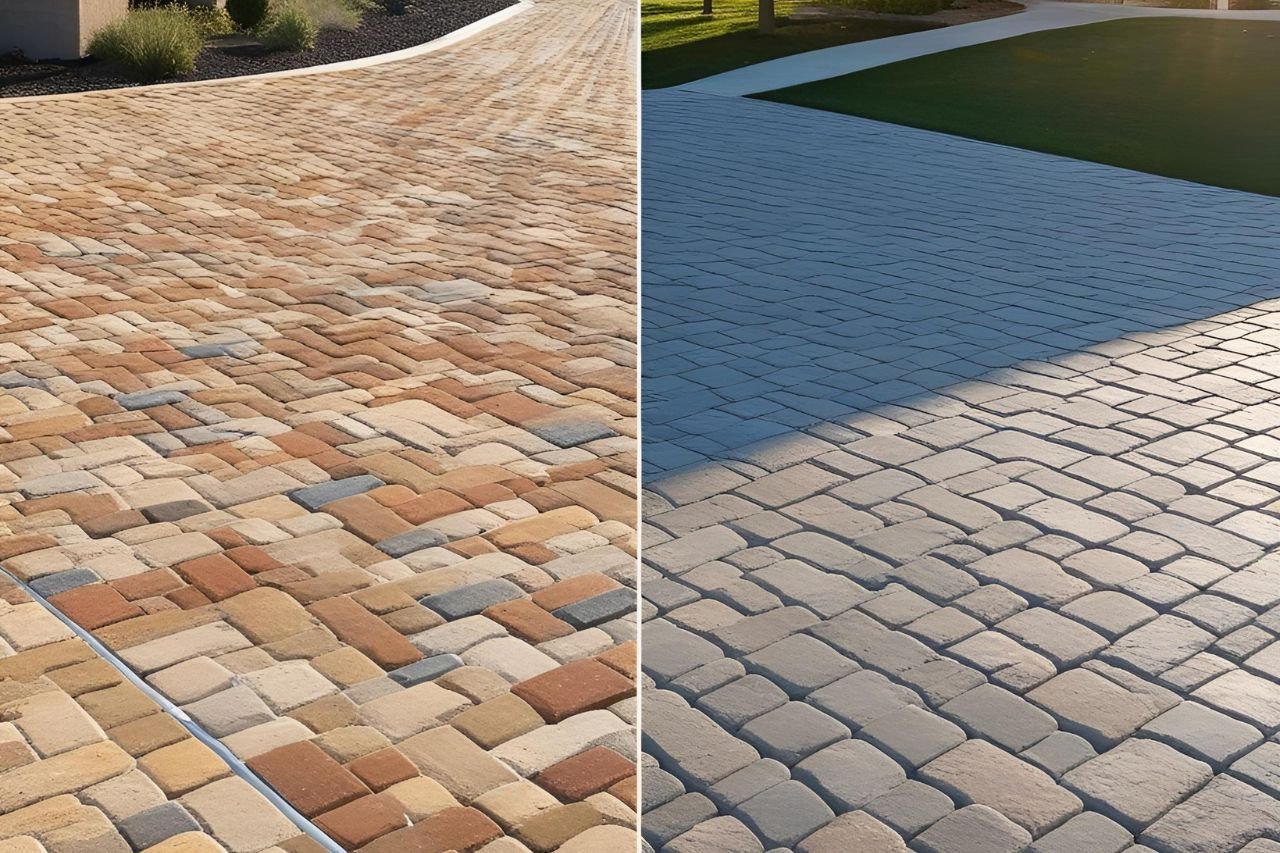Residential and commercial paver installations differ in terms of scope, material selection, design complexity, and durability requirements. Commercial projects often require larger areas, high-traffic durability, and custom designs, while residential installations focus on smaller, decorative spaces like patios and driveways.
Understanding Residential and Commercial Paver Installation
Residential paver installations are designed for aesthetic appeal and homeowner usage, while commercial installations prioritize functionality and durability for business spaces. Both projects require careful planning, but their goals and demands vary significantly.
1. Project Scope and Area Size
Residential paver projects typically cover smaller areas, such as patios, driveways, or walkways. These spaces prioritize aesthetics and personal use. Commercial installations often involve larger spaces, such as parking lots, courtyards, and entryways, built to accommodate heavy traffic.
For large-scale commercial projects, durable materials are essential. Explore material options tailored to different project scopes in paver installation services.
2. Material Selection
Residential installations often use decorative materials like brick, concrete, or natural stone for visual appeal. Commercial projects use heavy-duty materials with high load-bearing capacity, such as reinforced concrete and permeable pavers.
Best material choices include:
- Residential: Brick pavers for walkways or natural stone for patios.
- Commercial: Permeable pavers for parking lots to manage water runoff.
Learn more about material selection for Odessa homes in the best materials for paver projects.
3. Design Features and Complexity
Residential spaces focus on creating visually appealing designs, such as intricate patterns or themed layouts. Commercial spaces prioritize functionality, with minimalistic or uniform designs that accommodate heavy traffic and large-scale usage.
Complex designs for homes require precise options, while commercial projects often involve standard layouts for efficiency.
4. Durability Requirements
Commercial installations require pavers that withstand heavy loads, frequent foot traffic, and exposure to weather. Permeable pavers, known for their strength and drainage capability, are common in commercial setups. Residential pavers prioritize moderate durability paired with aesthetics.
For details on improving durability during installation, visit how installation quality supports future sealing.
5. Traffic Volume and Usage
Residential spaces are designed for limited traffic, focusing on personal and guest usage. Driveways and patios experience moderate wear. Commercial spaces are built for high traffic, such as vehicles, pedestrians, and heavy equipment, requiring robust materials and proper base preparation.
6. Site Preparation Differences
Residential installations require basic preparation, such as leveling and compacting smaller areas. Commercial sites demand advanced preparation, including deep excavation and reinforced base layers for stability under heavy traffic loads.
7. Project Timelines and Labor Requirements
Residential paver installation projects are typically completed within 2–5 days. Commercial installations, covering large areas, may take 1–2 weeks or longer due to their complexity and scope.
For typical project timelines, read about paver installation timelines in Odessa from our experts.
8. Maintenance Requirements
Residential pavers require periodic cleaning and occasional resealing to preserve their appearance. Commercial pavers demand frequent inspections and maintenance due to constant wear and exposure to traffic.
Proper installation techniques minimize maintenance needs for both residential and commercial spaces. For tips on avoiding installation pitfalls, refer to common installation mistakes.
9. Cost Implications
Residential paver installation costs are typically lower due to smaller project scopes and fewer material requirements. Commercial installations involve higher costs due to larger areas, durable materials, and advanced labor requirements.
Comparison Table: Residential vs. Commercial Pavers
| Feature | Residential Paver Installation | Commercial Paver Installation |
|---|---|---|
| Project Scope | Smaller areas like patios or driveways. | Large spaces like parking lots or courtyards. |
| Material Selection | Decorative materials like brick. | Durable options like permeable pavers. |
| Design Complexity | Intricate patterns and themes. | Functional and uniform designs. |
| Durability Requirements | Moderate durability for personal use. | High durability for heavy traffic. |
| Traffic Volume | Limited traffic usage. | Continuous and high-volume traffic. |
| Installation Timeline | 2–5 days. | 1–2 weeks or longer. |
Frequently Asked Questions
1. Do commercial paver installations require specific materials?
Yes, commercial spaces require high-strength materials like reinforced concrete or permeable pavers.
2. How do residential and commercial project timelines differ?
Residential installations typically take 2–5 days, while commercial projects may take 1–2 weeks or more.
3. Are maintenance needs different for residential and commercial pavers?
Yes, residential pavers require occasional cleaning and resealing, while commercial surfaces demand frequent inspections and maintenance.
4. Why is site preparation more complex for commercial installations?
Commercial sites need deeper excavation, reinforced bases, and advanced drainage solutions to handle heavy loads.
5. Can residential spaces use commercial-grade paver materials?
Yes, durable commercial-grade materials can be used for residential spaces to improve longevity.
Call Us Today
Choosing the right installation and sealing strategy for residential or commercial pavers in Odessa ensures lasting durability and appealing design. Professional services streamline the process, delivering tailored results for any project size. Contact our team to schedule expert paver installation services for your property.


